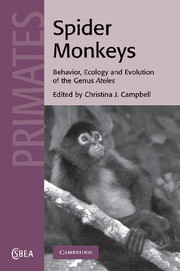Book contents
- Frontmatter
- Contents
- List of contributors
- Acknowledgements
- 1 Introduction
- Part I Taxonomy, phylogeny and evolution
- Part II Ecology
- 4 Diets of wild spider monkeys
- 5 Factors influencing spider monkey habitat use and ranging patterns
- 6 Spider monkeys as seed dispersers
- Part III Behavior and reproduction
- Part IV Interactions with humans
- Index
- References
4 - Diets of wild spider monkeys
Published online by Cambridge University Press: 05 May 2010
- Frontmatter
- Contents
- List of contributors
- Acknowledgements
- 1 Introduction
- Part I Taxonomy, phylogeny and evolution
- Part II Ecology
- 4 Diets of wild spider monkeys
- 5 Factors influencing spider monkey habitat use and ranging patterns
- 6 Spider monkeys as seed dispersers
- Part III Behavior and reproduction
- Part IV Interactions with humans
- Index
- References
Summary
Introduction
The first comprehensive field study of wild spider monkeys was undertaken in Panama in the early 1930s by C. R. Carpenter. In discussing the diet of Ateles geoffroyi, Carpenter (1935) wrote, “Red spider monkeys have been classed correctly as frugivorous. It is estimated that about 90 percent of their food consists of fruit or nuts” (p. 174). Since that time, field studies of wild Ateles have consistently confirmed Carpenter's early assessment of the highly frugivorous diet of spider monkeys, to the point where they are now treated as a classic example of a frugivorous primate and are often considered to be “ripe fruit specialists” (Cant, 1977; Klein and Klein, 1977; van Roosmalen, 1985; van Roosmalen and Klein, 1988; Cant, 1990; Dew, 2005; Wallace, 2005; Di Fiore and Campbell, 2007). In this chapter, we first review what is known of the diet of wild Ateles, paying particular attention to data from long-term ecological studies. In doing so, we address the physiological and morphological adaptations for frugivory that spider monkeys have evolved, as well as the connections among diet, food resource distribution and foraging behavior that are relevant to understanding the characteristic “fission–fusion” social organization of Ateles.
From there, we move on to discussing the interesting variation seen in the diets of spider monkeys across tropical forest sites, and we address in more detail the diets of two populations of white-bellied spider monkeys (Ateles belzebuth belzebuth) which we and our colleagues and collaborators have studied over multiple years in Colombia and Ecuador.
- Type
- Chapter
- Information
- Spider MonkeysThe Biology, Behavior and Ecology of the Genus Ateles, pp. 81 - 137Publisher: Cambridge University PressPrint publication year: 2008
References
- 54
- Cited by

